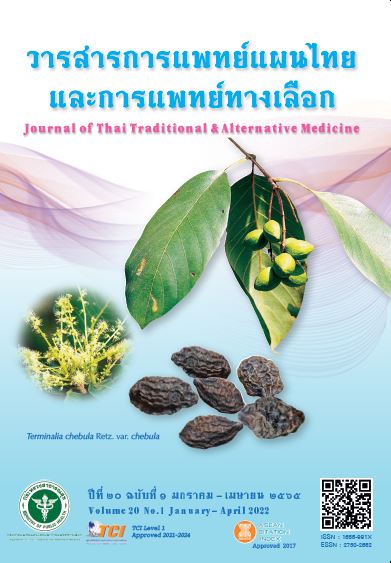Antibacterial Activity against Common Human Pathogenic Bacteria of Edible Aquatic Plant Extracts
Main Article Content
Abstract
Bacterial antibiotic resistance is a big issue of mankind. It is thus necessary to discover new compounds with high antibacterial activity from natural sources for further development as a new effective antibacterial drug. In this study, 12 edible aquatic plants were collected from nature and fresh markets in Phitsanulok province based on their therapeutic uses in Thai traditional medicine, biological properties and secondary components in the edible parts. Absolute ethanol extraction of dried pieces of the plants was undertaken. Afterwards, the crude extracts were screened for antibacterial activity against five human pathogenic bacteria using agar-disc diffusion assay. Based on their antimicrobial activities, the plants were classified into five groups: 1) high activity – Ludwigia adscendens and Limnocharis flava; 2) quite high activity – Nelumbo nucifera, Ipomoea aquatica; 3) moderate activity – Diplazium esculentum, Nymphaea pubescens, Hydrocotyle speciose; 4) low activity – Neptunia oleracea Sesbania speciose; and 5) no activity – Wolffia globosa, Eichhornia crassipes, Marsilea crenata. The extracts had more inhibitory activity on Gram positive than Gram negative bacteria, ranging from high to low: Staphylococcus pyogenes > Streptococcus pneumoniae > Salmonella typhimurium > Staphylococcus aureus > Escherichia coli. The minimum inhibitory concentration testing by micro-dilution assay confirmed that L. adscendens more dramatically affected Gram positive S. pyogenes and S. pneumoniae (MIC 0.625 mg/mL) than Gram negative S. typhimurium (MIC 5 mg/mL), whereas L. flava showed a similar effect on tested bacteria (MIC 1.25 mg/mL). Taken together, L. adscendens and L. flava are promising aquatic sources for further application.
Article Details

This work is licensed under a Creative Commons Attribution-NonCommercial-NoDerivatives 4.0 International License.
References
Wutithumawech W. Pharmacy Ratanakosin. 3rd ed. WutithummawechThai traditional medicine. 2010. 720 p. (in Thai)
Nangngam P. Edible aquatic plants. Phitsanulok: Focus printing; 2017. 150 p. (in Thai)
Jani M, Shah S, Prajapati S. Antibacterial screening and qualitative phytochemical estimation of selected aquatic plants. Advan. Biol. Res. 2012;6(1):19-23,
Tungmunnithum D., Kongsawadworakul P., Hano C. A cosmetic perspective on the antioxidant flavonoids from Nymphaea lotus L. Cosmetics. 2021;8(12):1-9.
Thamlikitkul V. Thailand antimicrobial resistance containment and prevention program. Bangkok: Division of Infectious Diseases and Tropical Medicine, Faculty of Medicine Siriraj Hospital, Mahidol University; 2015. 114 p. (in Thai)
Sritubtim S., Krapeedeang S., Wongsa N. Biological activities on growth inhibition of bacteria of medicinal plant extracts from plants found in the upper Northeastern Thailand. SDU Res. J. 2014;7(1):21-39. (in Thai)
Kim S.Y., Kang D.H., Kim J.K., Ha Y.G., Hwang J.Y., Kim T., Lee S.H. Antimicrobial activity of plant extracts against Salmonella typhimurium, Escherichia coli 0157:H7, and Listeria monocytogenes on fresh lettuce. J Food Sci. 2011;76(1):M41-6.
Bunpatanasak S., Siriyota K. Bacterial pathogens causing food poisoning in health regions 2 and Phichit province in 2013-2017. Journal of Disease Prevention and Control: DPC.2 Phitsanulok. 2019;6(1):1-15. (in Thai)
Pornsakda S., Plainsirichai M., Srisaeard K., Nakornreab M., Laopraserd P., Vichitsoonthonkul T., Photchanachai S. Effect of plate brush (Solanum torvum Sw.) crude extract on the inhibition of pathogenic bacteria (Escherichia coli, Staphylococcus aureus and Salmonella typhimurium). Agricultural Sci. J. 2010;41(3/1):573-6. (in Thai)
Jantanu S., Yuentrakul P., Jirapong C. Inhibition of Streptococcus pyogenes by edible film containing Moringa oleifera Lam. extracts. Huachiew Chalermprakiet Sci Tech. 2016;2(2):20-7. (in Thai)
Chahomchuen T., Siramon P. Antimicrobial activity of crude extract from Rhizophora barks. King Mongkut's Agricultural Journal. 2019;37(2):212-20. (in Thai)
Ratananikom K., Srikacha N., Khannaloa Y. Antibacterial activity of Artocarpus lakoocha Roxb. crude extract towards common human pathogens. J Thai Trad Alt Med. 2019;17(1):54-62. (in Thai)
Barman A.K., Kha A., Sarkar K.K., Dev S., Das A.K., Biswas N.N. Antioxidant, antibacterial and toxicity studies of aerial parts of Ludwigia adscendens L. Khulna University Studies. 2018;15(1&2) 23-36.
Aunjum A., Biswas R., Ullah M.S., Billah M.M., Islam E.D., Islam K.D. Bioactivity analysis of Sarcolobus globosus Wall., a mangrove plant of the Sundarbans. J Bangladesh Agril Univ. 2019;17(4):476-82.
Shilpi J.A., Gray A.I., Seidel V. Chemical constituents from Ludwigia adscendens. Biochemical systematics and ecology. 2010;38(1):106-9.
Ooh K.F, Ong H.C, Wong F.C, Chai T.T. HPLC profiling of phenolic acids and flavonoids and evaluation of anti-lipoxygenase and antioxidant activities of aquatic vegetable Limnocharis flava. Acta Pol Pharm. 2015;72(5):973-9.
Sruthi A., Panjikkaran S.T., Aneena E.R., Pathrose B., Mathew D. Insights into the composition of lotus rhizome. Journal of Pharmacognosy and Phytochemistry. 2019;8(3):3550-5.
Gad M.H, Tuenter E., El-Sawi N., Younes S., El-Ghadban E.M., Demeyer K., Pieters L., Heyden Y.V., Mangelings D. Identification of some bioactive metabolites in a fractionated methanol extract from Ipomoea aquatica (aerial parts) through TLC, HPLC, UPLC-ESI-QTOF-MS and LC-SPE-NMR fingerprints analyses. Phytochem Anal. 2018;29(1):5-15
Watanabe M., Miyashita T., Devkota H.P. Phenolic compounds and ecdysteroids of Diplazium esculentum (Retz.) Sw. (Athyriaceae) from Japan and their chemotaxonomic significance. Biochemical Systematics and Ecology. 2021;94:104211.
Hamdy S.A., Hefnawy H.M., Azzam S.M., Aboutabl E.A. Chemical profiling, volatile oil analysis and anticholinesterase activity of Hydrocotyle umbellata L. aerial parts cultivated in Egypt. South African Journal of Botany. 2018;115:108-12.
Lee S.Y., Mediani A., Ismail I.S., Maulidiani, Abas F. Antioxidant and -glucosidase inhibitors from Neptunia oleracea fractions using 1H NMR-based metabolomics approach and UHPLC-MS/MS analysis. BMC Complement Altern Med. 2019;19(7):1-15.
Kathiresh M., Devi P.S., Saravanakumar M. Bioactive compounds in Sesbania sesban flower and its antioxidant and antimicrobial activity. Journal of Pharmacy Research. 2012;5(1):390-3.
Anusiya G., Bharathi S., Mukesh P.K., Sainandhini G., Gowthama P.U. Extraction and molecular characterization of biological compounds from water hyacinth. Journal of Medicinal Plants Studies. 2020;8(5):14-9.
Ma’arif B., Agil M., Laswati H. Phytochemical assessment on n-hexane extract and fractions of Marsilea crenata Presl. leaves through GC-MS. Trad. Med. J. 2016;21(2):77-85.
Elshikh M., Ahmed S., Funston S., Dunlop P., McGaw M., Marchant R., Banat I.M. Resazurin-based 96-well plate microdilution method for the determination of minimum inhibitory concentration of biosurfactants. Biotechnol Lett. 2016;38(6):1015–9.
Lui J., Du C., Beaman H.T., Monroe M.B. Characterization of phenolic acid antimicrobial and antioxidant structure-property relationships. Pharmaceutics. 2020;12(419):1-17
Oloyede H.O.B., Ajiboye H.O., Salawu M.O., Ajiboye T.O. Influence of oxidative stress on the antibacterial activity of betulin, betulinic acid and ursolic acid. Microb Pathog. 2017;111:338-44.


